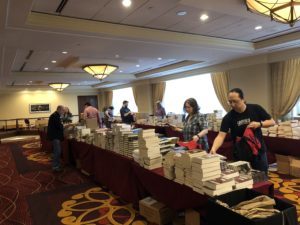Cat Rambo's Blog, page 30
June 26, 2018
Guest Post: N.J. Schrock on Writing Misterioso
In my backyard, I have a tree whose fruit is colored bottles, and it serves a useful purpose. The bottles trap and kill evil spirits. During the night, evil spirits wander into the bottles, and they can’t find their way out—basically like a lobster trap for spirits. Then, when the morning sunlight hits the bottles, the evil spirits, which don’t like sunlight, are burned away. Poof!
Skeptical? Where’s your sense of mystery? The bottle tree legend is believed to have originated in Africa and been brought to the states with African slaves, which is why you’re more likely to see one in the South. Being a transplanted Yankee, I’d never seen a bottle tree until I experienced one years ago at The Antique Rose Emporium in Brenham, Texas. It was a thing of beauty, and a sign nearby explained the legend. I thought the idea was so cool that I wanted to have one, but I needed the right structure. Some people use welded metal rods, but I wanted something more organic. So, when our Majestic Indian Hawthorn tree died last year, I saw an opportunity to have a bottle tree although I knew it would take some work.
 With its dry, rust-colored leaves and green lichen, the tree still had a unique beauty, but it wouldn’t have lasted. Something needed to be done. I could have cut it down and planted something else, but the surrounding live oak trees had caused this area of the yard to become too shady for most trees to grow. I think the shade is what killed this one. But every morning, sunlight climbs over our fence, around a large magnolia, and underneath the branches of the live oak, and it illuminates the dead tree for at least an hour. The morning sunlight may have been what spawned my idea of turning it into a bottle tree. I saw an opportunity to take a dead thing and turn it into—I hoped—an attractive lawn ornament. And maybe, I thought, I might even eliminate some evil spirits wandering around the neighborhood—at which point, my left brain started screaming at me, “Are you #$%&ing kidding me? Evil spirits? What is this? Pre-enlightenment?” To which, my right brain answered, “Really? Every culture has stories of good and evil spirits, so how do you know that they don’t exist?” I imagine my left hand went up to rub and soothe my left temple.
With its dry, rust-colored leaves and green lichen, the tree still had a unique beauty, but it wouldn’t have lasted. Something needed to be done. I could have cut it down and planted something else, but the surrounding live oak trees had caused this area of the yard to become too shady for most trees to grow. I think the shade is what killed this one. But every morning, sunlight climbs over our fence, around a large magnolia, and underneath the branches of the live oak, and it illuminates the dead tree for at least an hour. The morning sunlight may have been what spawned my idea of turning it into a bottle tree. I saw an opportunity to take a dead thing and turn it into—I hoped—an attractive lawn ornament. And maybe, I thought, I might even eliminate some evil spirits wandering around the neighborhood—at which point, my left brain started screaming at me, “Are you #$%&ing kidding me? Evil spirits? What is this? Pre-enlightenment?” To which, my right brain answered, “Really? Every culture has stories of good and evil spirits, so how do you know that they don’t exist?” I imagine my left hand went up to rub and soothe my left temple.
Seriously, as a scientist turned fiction writer and visual artist, my left brain and right brain war with each other constantly. My left brain would like to think that we live in a world where physical phenomena can be explained, and we humans are in control of our destiny. And then my right brain feels trapped and constrained. It asks why we have crowded out life’s mysteries with data and facts, and it points to the many, many things we don’t know and can’t explain. It liked a book I read recently called We Have No Idea: A Guide to the Unknown Universe, by Jorge Cham and Daniel Whiteson, which is about the physics of the universe and what we can’t explain. My right brain is also currently having fun reading a couple of fantasy books: D. L. Jenning’s Gift of the Shaper, and Cat Rambo’s Hearts of Tabat. Both of these books have taken me to places and given me adventures that I wouldn’t have imagined. My right brain also points to the classics in metaphysics, told through mythos, because this is the language that explains our major religions, which all wrestle with the clouds of unknowing and mysteries larger than ourselves. I have come to realize that this war in my brain is why I like to write and read science fiction. I get to use both sides—when they cooperate with each other. Good sci-fi and fantasy books build worlds believable within the texts, yet either delve into or create their own mysteries, things not known or understood. Yet this exploration of and embracing of mystery is not for everyone.
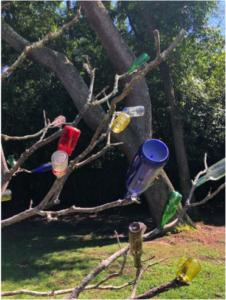 I recently wrote a blog post about reading the literary great Flannery O’Connor’s book Mystery and Manners: Occasional Prose. In it, she discusses her thoughts on writing fiction, and one of her themes is the role of mystery in fiction. She says, “It is the business of fiction to embody mystery … and mystery is a great embarrassment to the modern mind” (p. 124). It can be an embarrassment because we humans labor under the delusion that we can know all things if we can just construct a predictive model and work out the mathematics. This premise has worked well for us in the past and brought us pharmaceuticals, electronics, spaceships, and smart phones. But, in the absence of a grand unified theory of matter after decades of trying, some scientists are beginning to wonder if mathematics has its limits. Are there things it can’t do? The answer to this question brings me back to the evil spirits that I’ve been trapping in my colored bottles.
I recently wrote a blog post about reading the literary great Flannery O’Connor’s book Mystery and Manners: Occasional Prose. In it, she discusses her thoughts on writing fiction, and one of her themes is the role of mystery in fiction. She says, “It is the business of fiction to embody mystery … and mystery is a great embarrassment to the modern mind” (p. 124). It can be an embarrassment because we humans labor under the delusion that we can know all things if we can just construct a predictive model and work out the mathematics. This premise has worked well for us in the past and brought us pharmaceuticals, electronics, spaceships, and smart phones. But, in the absence of a grand unified theory of matter after decades of trying, some scientists are beginning to wonder if mathematics has its limits. Are there things it can’t do? The answer to this question brings me back to the evil spirits that I’ve been trapping in my colored bottles.
I don’t expect an evidence that I’m reducing the evil spirits in our neighborhood. If I could show evidence, I’d lobby to install several in Washington D.C. But then, the tree would have to be the size of the Rockefeller Plaza Christmas tree in order to accommodate the five-gallon jugs required to haul in the spirits that cause discord, the unwillingness to compromise, and lack of empathy. The last spirit is particularly polarizing and, coincidentally, something that good fiction can address.
Recent Trends in Cognitive Science published a study a couple of years ago showing that people who read character-driven fiction are more empathetic. Reading and understanding stories helps people imagine other worlds and other consciences. And these other-person experiences are part of the mystery of good fiction, and in particular good science fiction and fantasy. Experiences and the meaning of those experiences are different for everyone who reads a story or novel. We all as readers ascribe our own meanings to a text.
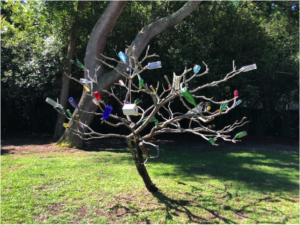 This experienced meaning is, I think, the reason why I’ve had a hard time reducing my novel Incense Rising to a movie-trailer synopsis. When asked what it’s about, I usually say the genre is speculative fiction or science fiction—but not like Star Wars—and the plot is around a scientist who becomes a fugitive to save a scientific theory; however, in a deeper sense, it explores the commercialization of our humanity. I felt bad about my shortcomings around writing a good elevator pitch until I read O’Connor’s view of experienced meaning in novels: “The meaning of a story has to be embodied in it, has to be made concrete in it. … When anybody asks what a story is about, the only proper thing is to tell him to read the story. The meaning of fiction is not abstract meaning but experienced meaning, …” (Mystery and Manners, p. 96). Yes! The mystery of fiction is in the experienced meaning, the many experienced meanings. We authors take readers on journeys, and they end up somewhere different from where they started. I’ve come to understand something of this mystery of fiction and why we like it and why we should read more of it, but I never expected that creating a bottle tree would relate to any of these insights on why I write.
This experienced meaning is, I think, the reason why I’ve had a hard time reducing my novel Incense Rising to a movie-trailer synopsis. When asked what it’s about, I usually say the genre is speculative fiction or science fiction—but not like Star Wars—and the plot is around a scientist who becomes a fugitive to save a scientific theory; however, in a deeper sense, it explores the commercialization of our humanity. I felt bad about my shortcomings around writing a good elevator pitch until I read O’Connor’s view of experienced meaning in novels: “The meaning of a story has to be embodied in it, has to be made concrete in it. … When anybody asks what a story is about, the only proper thing is to tell him to read the story. The meaning of fiction is not abstract meaning but experienced meaning, …” (Mystery and Manners, p. 96). Yes! The mystery of fiction is in the experienced meaning, the many experienced meanings. We authors take readers on journeys, and they end up somewhere different from where they started. I’ve come to understand something of this mystery of fiction and why we like it and why we should read more of it, but I never expected that creating a bottle tree would relate to any of these insights on why I write.
Creating the bottle tree itself was a journey. I started sometime last November by sawing off small or weak branches, removing leaves, and scraping off the lichen. Then I began collecting different colored bottles with openings large enough to fit over the branches. I took pictures of the bottles in the sunlight, moved them around, discovered what they do collect—spider webs, an occasional bug, and condensation—and I even installed a birdhouse. And, somewhere between creating a bottle tree and reading Flannery O’Connor’s Mystery and Manners, I had an epiphany about the value of nurturing life’s mysteries, why I like to read and write science fiction, and why more people should read fiction. We all need some mystery, empathy for others, and maybe even a bottle tree.
Nancy’s most recent book is Incense Rising, a near future SF thriller set in a world where consumerism and politics have merged,
Author bio: I have been writing all my life although I began trying to publish my fiction only recently. My story ideas usually start with a “what if?” question. For example, what if we encountered alien life forms with a copper-based oxygen transport instead of hemoglobin? The result: “The Silver Strands of Alpha Crucis-d,” published by The Magazine of Fantasy & Science Fiction, Mar/Apr 2016.
I may have taken a convoluted path to arriving at writing speculative fiction, but now that I have, I can’t believe I didn’t do this sooner because I’m having so much fun!
Asking “what if” questions is an important part of engaging in scientific research, which is what I did for many years. After earning a Ph.D. in organic chemistry from the University of Illinois, I went to work for a large chemical company and spent twenty-five years engaged in research. In 2012, I earned a master’s degree in English from the University of West Florida (UWF), and I’ve been writing fiction, creative nonfiction, and poetry ever since. I teach classes in organic chemistry and writing for STEM majors as an Adjunct Instructor at UWF. When I’m not writing or teaching, I like to do artwork. I’m a member of Quayside Art Gallery in Pensacola, where I work two days a month.
Find Nancy’s website at https://njschrock.com or follow her on Twitter.
May 30, 2018
Guest Post: Robyn Bennis Provides a Debut Author’s Guide to Social Anxiety
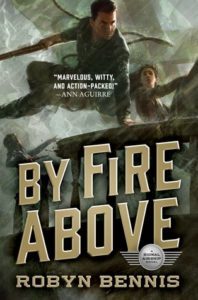 People frighten and confuse me.
People frighten and confuse me.
It’s not their fault. Well, sometimes it is, but that’s a topic for a different day. Today, I’d like to take you on a journey into the awkward glory of social anxiety. If you don’t suffer from this annoying malady, this article may not be for you, though I’d appreciate it if you’d keep reading anyway, because my second book just came out and heaven knows I need the exposure.
Most people don’t peg me for socially anxious, and I don’t blame them for missing it. I’m chatty enough with people I know, and I’m always the first to throw out an inappropriate comment. Indeed, in groups of more than three but fewer than seven, with at least two friends present, I can be absolutely effervescent. You might even say that I’m the life of a very limited range of small parties.
But if you get me in a crowd and tell me to mingle, you had better be ready for a nervous breakdown.
Have someone you need me to introduce myself to? Sorry, they look really busy sitting alone at that table, quietly refolding their napkin. Maybe later, when they’re not so preoccupied.
Got a small favor I should ask of a friend? That feels too much like imposing.
Trying to make me the center of attention? Then the center of attention is going to be a cloud of dust where I was just standing.
Want me to maintain more than a tenth of a second of nervous eye contact with you? Whoa, save something for marriage there, Speedy McTooFast.
Even with the wonderful and supportive friends that I’m lucky enough to have, I always manage to sabotage any attempt at helping me. “You looked like you wanted to be alone,” they’ll say, the day after a party. Inevitably, it’ll be a party that I spent standing in the corner, faking Barkleyesque interest in a potted fern, paralyzed, afraid to approach any of the clusters of conversation.
The real problem is that my own brain conspires against me, particularly at gatherings of other writers. “No, they’re too good for you,” it says. “One of them has a Hugo. What the hell do you have?” If I intentionally seek out a less-intimidating group, I still find ways to scare myself away. “Oh, think you’d fit in better with them? Didn’t you say a few words to two of them an hour ago? They’re probably exhausted with you after that.” Even when my wonderful friends try to help, my traitorous brain sabotages their efforts. “What, them?” it asks. “Those friends who specifically told you to join them anytime, that you were always welcome, and specifically mentioned that they were making it their mission to help you socialize? Well, that just proves they’re tired of your nonsense, doesn’t it? Better duck out before you ruin their night.” And then my brain cackles evilly as I make my way to the exit.
If this seems familiar to you, don’t despair, because there is something you can do about it: go see a psychiatrist.
Sorry, were you expecting a treatise on coping mechanisms? A weird old trick, perhaps? Yeah well, the weird old trick is to see a psychiatrist already. Because, if your social anxiety is so bad that the above is familiar, then any coping mechanisms you possess are probably being employed as excuses to not get the help you need.
If, on the other hand, the above feels like a gross exaggeration of your social anxiety, then perhaps I do have a handful of weird old tips for you.
Perhaps the most important thing is to have someone on your side. I am extremely lucky to have talented and fearless people who want me to succeed, and it has helped immeasurably. Now, this may seem like a bit of a paradox. Social anxiety can make recruiting your friends not just a Herculean task, but a mild imposition on them, and therefore an impossible request. “How can I make such a request,” you say, “as worthless and unworthy as I am? My friend surely has better things to do—like staring into space or streaming the complete run of She’s the Sheriff. I can’t let them waste their time on me.”
To get over this, the first thing you have to do is acknowledge that your brain is lying to you. I mean, Suzanne Somers is great and all, but that show just doesn’t hold up. Good acting can only go so far in saving such a horrible premise.
Oh, and your brain is also lying about your worthlessness. You are worthy and deserving of the help of others. But seriously, who the hell thought that show was a good idea?
The second most important thing is to force yourself to do the things you dread. Stand in sight of your friends at that social event. Believe in their sincerity when they wave you over. Promise yourself that you’ll say hello to those people you talked to earlier. If you must stare at your feet, put one in front of the other until you find yourself in front of that guy with the Hugo and you have no choice but to shake his hand. You needn’t be afraid. He probably won it in an off year, anyway. It’s not like he’s Ted Chiang, or something. I mean, unless he really is Ted Chiang, in which case you should probably just run.
The point is, throw yourself into the very situations you’re most afraid of, to teach yourself that they will not end in tears, chaos, and disaster. Outflank your lying brain by maneuvering yourself into social obligations you can’t back out of. When there’s nowhere to go but forward, that’s where you’ll go, and you’ll learn the terrain along the way. And when you screw it up, don’t get mad at yourself. Treat it as a training exercise instead.
Oh, and if you happen to see me at a convention? Come on over and say hello. I don’t bite, except when cornered.
 Robyn Bennis is a writer and biologist living in Madison, Wisconsin. The latest book in her Signal Airship series is By Fire Above, which Publishers Weekly calls an “introspective study of the morality of war in a fantastical steampunk setting.” She has run from Ted Chiang on at least one occasion.
Robyn Bennis is a writer and biologist living in Madison, Wisconsin. The latest book in her Signal Airship series is By Fire Above, which Publishers Weekly calls an “introspective study of the morality of war in a fantastical steampunk setting.” She has run from Ted Chiang on at least one occasion.
Follow her on Twitter. Find her website here.
Want to write your own guest post? Here’s the guidelines.
May 26, 2018
The Merqueen’s Report: Nebula Awards Weekend, 2018
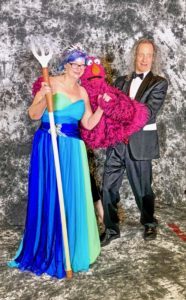 I will add more pictures in later, editing them in as they get processed. For now, I want to record some of my thoughts and memories from the past weekend and the Nebula Awards conference weekend, before a brand-new weekend eclipses any part of the splendor. Kudoes to the Science Fiction & Fantasy Writers of America events team, particularly Kate Baker, Mary Robinette Kowal, Terra LeMay, Laurie Mann, and Steven H Silver, for work well done.
I will add more pictures in later, editing them in as they get processed. For now, I want to record some of my thoughts and memories from the past weekend and the Nebula Awards conference weekend, before a brand-new weekend eclipses any part of the splendor. Kudoes to the Science Fiction & Fantasy Writers of America events team, particularly Kate Baker, Mary Robinette Kowal, Terra LeMay, Laurie Mann, and Steven H Silver, for work well done.
I flew into Pittsburgh on a Tuesday, getting there late enough that I didn’t look for anyone after checking in, opting instead for a glass of wine, a piece of cheesecake, and quiet reading. In retrospect, that may not have been my smartest move, because my stomach was thoroughly upset by the time I got up the next day.
We (the members of the SFWA board) don’t usually get there on Tuesday, but this year the board was trying something new, a strategic visioning session. I’m glad to say that just about everyone from both the incoming and outgoing sets were able to attend and I look forward to catching up the couple of absent folks with all the amazing stuff we got done.
I cannot go into all of the details, nor will I post any of the pictures. But I will talk about some of the general things that emerged, and I’m pleased to say that we’ve figured out things like timelines and deliverables and measures of success, as well as assigning work items, most of whom did not have “Cat” written on a post-it in the “who will drive this” spot.
So what can you expect to see as a result of this session?
Better teamwork and communication. Several exercises demonstrated how important those are, and underscored that even the best plans can breakdown when people are not talking to each other. We have been doing weekly video calls, and figured out a new plan in order to ensure every board member is attending at least one of those each month.
Better outward communication. Some restructuring of existing stuff (like the website) as well as new efforts.
More outreach. This will take a number of forms to both new and potential members, and the intent is to see them at both the local and global level — as well as virtual. You’ve seen a lot of this in recent years, including things like more and more of the local reading series. One new membership opportunity will be student memberships; look for details on that soon.
Cleaning house. We’ll be going through existing committees and programs as well as materials in order to make sure things are up to date and running smoothly. A new committee expediter role will help committees work together and make sure resources aren’t being overlooked.
Keeping existing efforts going. We’re almost at the end of getting the game Nebula stuff finalized. Things like SFWA Ed, First Chapters, and our new mentorship are all opening very soon while others are well under way, like the Speakers Bureau, Storybundle and NetGalley programs, and the Singularity (our member newsletter).
One reason I know this was a great session is that the next day we kept referring to it during the regular board meeting. We did go over by about twenty minutes that day, but that was partially because a couple of the morning hours were eaten by visioning stuff.
Midway through board stuff I stopped in at the 20 Books to 50k luncheon in order to meet old and new friends. Great stuff that gave me some new ideas about indie publishing.
Valiant volunteers and most of the board stffing books with reading goodness.
Thursday evening I helped stuff bookbags then hung out with a few friends before we had a reception in order to honor our new SFWA Grand Master, Peter S. Beagle, who was presented with a robot unicorn by Kate Baker and who read us all a story, in a lovely moment that just will linger with me forever. Beagle was sweet and kind and wonderful and a pure joy to be around throughout the weekend. For those following the saga of my wardrobe and make-up, I wore the handkerchief hem purple silk georgette with matching ballet flats.Wayne rolled in late that night. Friday morning we were officially off and running and everything is just a blur after that. Some highlights in roughly consecutive order.
For me Friday started with the Partners and Spouses event, also described as “Support Squad” in the program book. Gay Haldeman (Joe Haldeman’s wife) was our hostess, while Michelle Appel (author John Appel’s wife) helped facilitate and also provided adorable buttons, including a “Gay Haldeman is my shero” one in purple. My own spouse showed up and while it wasn’t a huge turnout, there were people, there were mimosas and snacks, and there were conversations and connections.
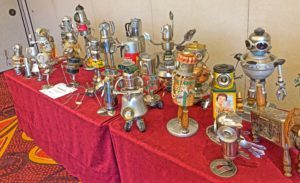 Before hitting the event, I checked the book depot to make sure I had everything I needed there. In Chicago, books had been a pain point when the bookseller proved inequal to the challenge of meeting the varied needs of our membership, letting down the small press and indie published people. I’m pleased to say that this year anyone who didn’t have books there could not complain it was due to any lack on SFWA’s part. While we’ve sold a little SFWA swag before, one new hit were the SFWA decoder rings introduced by Terra LeMay. I picked up a couple extra for friends; by the end of the weekend there were only a couple dozen left, which we’ll bring to Worldcon.
Before hitting the event, I checked the book depot to make sure I had everything I needed there. In Chicago, books had been a pain point when the bookseller proved inequal to the challenge of meeting the varied needs of our membership, letting down the small press and indie published people. I’m pleased to say that this year anyone who didn’t have books there could not complain it was due to any lack on SFWA’s part. While we’ve sold a little SFWA swag before, one new hit were the SFWA decoder rings introduced by Terra LeMay. I picked up a couple extra for friends; by the end of the weekend there were only a couple dozen left, which we’ll bring to Worldcon.
Another lovely addition to the book depot were Don Jones’ amazing robots, made from repurposed materials, which also served as centerpieces for the tables at the award banquet. i always enjoy seeing what the events team comes up with for table decorations and I picked up another robot this year to go with the one I acquired last year, which currently graces my coffee nook and makes me smile every morning.
Things I missed and wish I’d been able to get to: “Learn to Love the Microphone” with Sarah Pinsker; “Makeup for Writers” with Meg Frank, Mary Robinette Kowal, and Arkady Martine; An hour with Peter S. Beagle and Pat Rothfuss, oh cripes I’m writing down the whole program and will stop right now. Sarah Goslee livetweeted a bunch of them and it’s wroth taking a look back at the Nebulas2018 hashtag on twitter. One of the things I’m pleased with about the convention and expect to continue is that the programming is innovative and helping lead the way, just as SFWA does with other things like its Accessibility Checklist and anti-Harassment Guidelines. Some examples were the What Teens are Looking for in YA Literature featuring actual teens talking about what they wanted, the Office hours, the Mentor meet-ups, and the Alternate universe acceptance speeches.
My first panel was The Money is in Your (back)List with Margot Atwell, Michael Anderle, Jonathan Brazee and DongWon Song. A Geekwire piece had come out that morning including a quote from me talking about e-book pricing and we had a lively discussion of that post-panel.
After that I skedaddled to the mentor meetup! This new program has proven so successful that we’ll be offering a version of it at Worldcon, pairing up people new to the convention with someone who knows the ropes and thus can answer questions, provide guidance, and be a friendly face through the rest of the convention.
Friday night was the reception for the nominees. Huzzah! James Patrick Cronin and Mary Robinette Kowal read passages from the nominees’ work, which was a lot of fun, and I gave them their certificates, which always feels a bit awkward because I want to hug everyone because their work was so awesome and yet I do not want to intrude on anyone’s space. Evening ensemble: vintage black brocade dress, purple and gold sequined jacket, black ballet flats. After the reception I swung by the Archivos party up in the SFWA suite.
 Saturday morning Wayne and I had a lovely breakfast with the Haldemans, then I went off to the SFWA business meeting. That is worthy of its own recap (and will get one) but among the many things presented to the members: the mentorship program is up and ready to go, we had great participation in the membership survey and are using it to guide a lot of actions, the Self-Publishing committee is working at all sorts of good things including the First Chapters project and another Storybundle (the current one was the most successful yet), the YouTube channel is producing all sorts of good stuff with more on the way, the Legacy Committee has compiled a lot of useful stuff for authors who want to get their estates in order, and on and on.
Saturday morning Wayne and I had a lovely breakfast with the Haldemans, then I went off to the SFWA business meeting. That is worthy of its own recap (and will get one) but among the many things presented to the members: the mentorship program is up and ready to go, we had great participation in the membership survey and are using it to guide a lot of actions, the Self-Publishing committee is working at all sorts of good things including the First Chapters project and another Storybundle (the current one was the most successful yet), the YouTube channel is producing all sorts of good stuff with more on the way, the Legacy Committee has compiled a lot of useful stuff for authors who want to get their estates in order, and on and on.
Meanwhile the good parts of SFWA remain strong. The Contracts Committee, Grievance Committee, and Legal Affairs have all been working away on behalf of writers, including things like getting a foreign market that had published dozens of stories in translation without notification or payment to both knock it off and pay everyone, working with new markets to make sure they had good contracts, and teaming up with the Authors Coalition to weigh in on copyright and IP issues. A few years ago, finances were wobbly; they’re strong now and ready to take us through the rest of this century if we stay careful.
The election results were announced, with Lawrence Schoen staying on the board and Kelly Robson joining him. We are sorry to see John Murphy go but he’s agreed to keep working with the short fiction committee and moving them along to an effort to make the qualifying markets list more useful and informative to new writers.
Afterwards most of the board and staff stayed in the room for the SFWA services panel. We’ve been doing versions of this more and more at conventions (I just proposed one to World Fantasy) and it’s always popular. I refer you to Executive Director Kate Baker’s excellent write-up rather than try to recap.
After lunch, which I think I ate but don’t remember at all (like most of the meals that weekend), I co-presented “How to teach classes in storytelling” with J.R. Dawson. Dawson works primarily with children This was scheduled against one of the things I most wanted to see, the presentation “We’re Going to Need a Bigger Ship: Unclocking the Missing Half of the SF Market” by Data Guy.
At five, the always cool Monica Valentinelli came to my hotel room and helped me begin the transformation into Mer queen. I had tweeted about the dress months before, at which point my friend Kris Dikeman said it needed a seashell tiara, Nick Hyle then volunteered a trident, and by the time of the Nebulas I was a little worried it would turn out to be a costume instead of an outfit and instead it was GLORIOUS and I felt like the belle of the underwater ball.
Rather than recap, here’s the Youtube.
Having stuff up on the channel as well as livestreaming has been a goal of mine for a while – thank you volunteer Diane Morrison! Now it’s all been taking off. Afterwards I hung out in the hospitality suite, then staggered off to bed.
Sunday morning was time for my favorite part and another one I will take full credit for implementing, unlike most of the other stuff: the volunteer breakfast. We had close to fifty people show up this time, which was the third so far, and people seemed to happy to get their fancy certificates (suitable for framing!) and get a chance to talk with each other. I told the joke I stole from Joe Haldeman about SFWA, like soylent green, being made of people once again and a good time was had by all.
After that a had a panel on short story collections with Ellen Klages, David D. Levine, Todd Sanders, Caroline M. Yoachim. Yoachim showed off her new collection, Seven Wonders of a Once and Future World. we talked about a lot of whys and wherefores and I made sure that no one thought they were going to make money off short fiction.
The mass autographing was on Sunday instead of Friday this time and I’m still thinking whether or not that worked well, because a number of folks had already headed home by that point. I got Beagle to sign my copy of The Last Unicorn, which made me happy, and sat with Daryl Gregory, whose work I always enjoy, and whose Spoonbenders had been on the ballot.
After that I just wandered around aimlessly until I wandered into ops and we all sat around being braindead and then I remembered I had promised to meet Jenn Lyons and we ended up in what had become a very familiar bar by that point.
Monday I had breakfast with Micheal and Judith Anderle and Jonathan Brazee so we got a chance to talk indie, then ended up hanging with Ellen Klages for a few last hours. At the airport I encountered Jamie Wahls (nominated for Utopia, LOL?) in the lounge and we discovered a mutual appreciation of Harry Potter and the Methods of Rationality (which I still think should have won a Hugo) and he recommended a fun webserial Parahumans, which I’ve been working my way through.
TLDR version: everything was awesomepants and no reason to think next year won’t be even better, letting me head out of the SFWA Presidency on a lovely note in June 2019. *fingers crossed* I love you all.
May 24, 2018
Guest Post: E.D.E. Bell Serves Up Five Simple Vegan Foods to Try
Hello. I love, read, and write fantasy fiction. Oh, and I’m a vegan.
When I sell my fantasy novels at Comic Cons, I’ll usually sneak a little reference onto the bottom of my table white board, such as Vegan, or Vegan-friendly. In my mind, this covert signal will draw vegans to my table, whispering, “I am one too. Tell me, sister, about your fiction.” Like that first moment of connection in a dystopian novel. This doesn’t happen. Instead, people skip all the other great things on the board, point right to vegan, loudly state, “Look, it says veggan!” and then laugh. This hasn’t dissuaded me from the attempt. About half of those times, someone will ask, “Vegan-friendly fantasy fiction? What’s that?” They laugh. Then when I start to answer, they leave. Even more often, they point and laugh, then turn away.
In my mind, whenever someone asks what could be vegan about fantasy, it proves to me that they’ve never been a vegan reading fantasy. In addition to a lot of the violence and war in the genre (it’s usually a central component, even outside of grimdark), the best scenes feature someone riding their steed in a fine leather vest to grab a hock of ham. I’m not even sure I know what hocks are, but I have concluded they are key to the development of fantasy heroes. So, you know, my fiction is just focused a bit differently. In fact, I think that diversity and exploration is what fantasy is all about.
I’m not here to get into all of that, though. I’m here to talk about one of Cat’s and my favorite subjects: yummy food. Now, I’m not an authority on gourmet cuisine. Go to a vegan restaurant or check out many amazing online vegan chefs for that. (I’m particularly fond of Richa Hingle.) Hey, I’m not even a great cook. But I haven’t eaten meat in almost a quarter century, so I can definitely speak to “what we eat.” Don’t worry. This is just a quick blog to spark some ideas. But if you don’t mind eating plants, here are five simple foods you could give a spin.
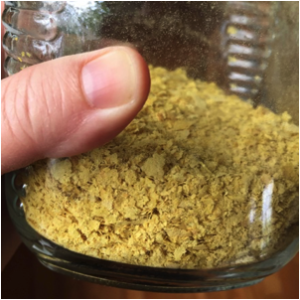
Here it is. Just a jar of yeast, with so many possibilities, as you will see below.
1. Nutritional YeastThis is a vegan staple, and yet so many people have never even heard of it. First, where to procure?
Any health food store should sell it in bulk, but even a standard grocery store should have a little plastic can of it. It’s rich in B vitamins and is often described with a nutty or cheesy taste. (It’s really a “yeasty” taste but no one wants to say that for obvious reasons.) Online vegans often say to sprinkle it on popcorn, but I find it a little dusty that way. Bloggers always show it on avocado toast, but the avocado doesn’t need it. I use it as a savory seasoning: in soups, in pasta, or even to make a quick vegan mac & cheese. Just get a bag and throw it on or in stuff. It’s good.

Some curried seitan slices, which I admit I ate after taking this photo.
2. Seitan
I do love a good tofu (I am so serious about tofu), and especially love when I can find local or handmade tofu. But there’s another common plant protein which with you may not be familiar. Seitan is essentially seasoned wheat gluten (or “wheat sausage” if you will), so it’s no good if you avoid gluten or eat gluten-free. Savory and rich, I really think you can’t beat a good homemade seitan. (Despite having more than one young hipster brag to me how much they love “eating Satan.”)
There are all kinds of searchable recipes, and I’d recommend using ones that incorporate lots of rich broth—and beer. (You don’t need the beer; it’s just got a flavor that works really well in seitan.) And if you don’t want to try making it, buy a good brand like Upton’s. It won’t be as juicy from the box, but still hearty and delicious.
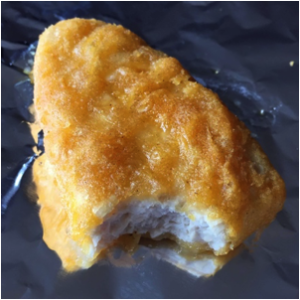
Fresh out of the toaster oven—and I may have taken a bite.
3. Packaged Plant ProteinI guess I should clarify that I’m a real-deal vegan. Without getting into it, that means I follow a belief system (an ethic) that also influences my diet. Not just a diet. This sometimes creates clashes with various plant-based diets that focus on health or shirk away from processed or commercial products.
No one should eat all packaged products. But if I had to, it might be the Gardein filets! Very likely in your grocer’s freezer too. It’s easy. Bake a couple of filets or tenders, cook a fresh tortilla (I buy ones without lard or non-vegan dough conditioners), and make a wrap with a few greens, some hot sauce, and a swipe of vegan cream cheese or mayo. I’m thinking about it now. Sigh.
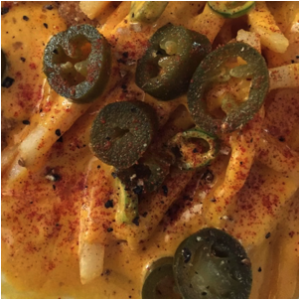
Don’t tell anyone about this, but I was in a mood one night recently and made this quick cheese sauce by blending cashews; nutritional yeast; boiled potato, carrots, and onion; and salt, pepper, garlic, and paprika. Then I poured it over fries and added sliced jalapeños. It was fast, decadent, and not as high-calorie as it looks.
4. Cashews!“But I’ve had cashews,” you say. “That’s just nuts.” But vegans use them as an easy source of cream or milk. You do really need a high-quality blender (e.g. Vitamix) to make this work, but if you have one, it’s very simple. It’s recommended to soak the cashews first (we soak a bunch then freeze them), but not required. You can make a quick milk just by blending cashews, water, and your preferred sweetener (or not). I use this for delicious fresh lattes, with a touch of maple syrup.
My favorite use is a quick red sauce (e.g. vodka or masala) by blending a handful of cashews, a can of tomatoes (with green chilies, even better) along with whatever vodka or spices you want. That can be poured over pasta, or used to simmer peas and tofu, or to dip that Gardein you bought, or for whatever!
5. Just grab a plant
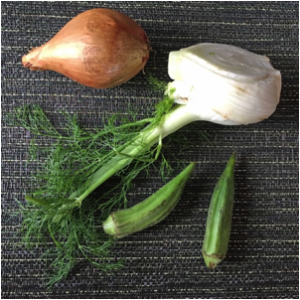
Some stuff I have laying around, ready for my next creation.
No, seriously, I’m not trying to get out of a fifth item here, but once you think more about plants, you’ll remember something you haven’t had for a while. I mean, I can’t just name all the plants. What do I eat? Sometimes a quick stir-fry. Other times a sandwich or freshly mashed guacamole. I can make soup dozens of different ways, all delicious and inexpensive. Stock spices. Stock your favorite grains. Simmer veggies in a rich sauce. Add fennel to pasta. Slice okra. Char corn. Glaze Brussels’ sprouts. Make a slaw. Throw in herbs. Or chop hot peppers. Bake potatoes. Add some Miyoko’s cheese or butter.
I could just go on and on, because quick staples I make for lunch are flashing in front of my eyes. Veggies are great! And maybe, like my fantasy heroes, you’ll be inspired to try one this week. If you do, tag me! I’d love to see what you make.
I hope that was fun—and maybe gave you some ideas for your next meal. I know I’m hungry, and since it’s five o’clock here, I’m off to break into that vegan wine. Want to connect? You can find me and my links at edebell.com. And you can check out my upcoming epic fantasy saga Diamondsong at atthisarts.com/diamondsong.
 Author: E.D.E. Bell was born in the year of the fire dragon during a Cleveland blizzard. With an MSE in Electrical Engineering from the University of Michigan, three wonderful children, and nearly two decades in Northern Virginia and Southwest Ohio developing technical intelligence strategy, she now applies her magic to the creation of genre-bending fantasy fiction in Ferndale, Michigan, where she is proud to be part of the Detroit arts community. A passionate vegan and enthusiastic denier of gender rules, she feels strongly about issues related to human equality and animal compassion. She is the author of the Shkode trilogy and the editor of the new anthology, As Told by Things. Her latest book Escape (Diamondsong Book 1) is available for preorder now! You can follow her adventures and social media at edebell.com.
Author: E.D.E. Bell was born in the year of the fire dragon during a Cleveland blizzard. With an MSE in Electrical Engineering from the University of Michigan, three wonderful children, and nearly two decades in Northern Virginia and Southwest Ohio developing technical intelligence strategy, she now applies her magic to the creation of genre-bending fantasy fiction in Ferndale, Michigan, where she is proud to be part of the Detroit arts community. A passionate vegan and enthusiastic denier of gender rules, she feels strongly about issues related to human equality and animal compassion. She is the author of the Shkode trilogy and the editor of the new anthology, As Told by Things. Her latest book Escape (Diamondsong Book 1) is available for preorder now! You can follow her adventures and social media at edebell.com.
May 15, 2018
Guest Post: Sheryl R. Hayers Stirs Up Crockpot Short Ribs of Hope
 I’m not the world’s best cook by any means. If given the option, to steal more time for writing I will order in or use prepackaged dinners. But there are things I make when I need that extra comfort that take-out or microwave meals won’t provide. It was no surprise that one of my favorite home-made meals made its way into my novel Chaos Wolf.
I’m not the world’s best cook by any means. If given the option, to steal more time for writing I will order in or use prepackaged dinners. But there are things I make when I need that extra comfort that take-out or microwave meals won’t provide. It was no surprise that one of my favorite home-made meals made its way into my novel Chaos Wolf.
In that scene, Jordan is due to present herself to the alpha werewolf of the Black Oak Pack for one final test. Alpha Shane has made it clear that if she can’t prove that she is in control her shapeshifting, he will kill her. She has just confronted Montgomery, her vampire mentor, about information he has withheld from her. Her trust in him is shaken when she needs his support the most. She’s exhausted emotionally and physically and needs something she can look forward to beyond mere survival. So she cooks.
Jordan doesn’t toss something into the microwave that warms up in two minutes. She doesn’t reach for the take-out cartons from the dinner the night before. She chooses to make a meal that will take a half hour to prepare and ten hours to cook.
In an act of quiet defiance against all of those who think she’s going to fail, Jordan chooses to hope that she will be there to eat it when it’s done. In her mind, it’s not her last meal, but her next meal to look forward to when she returns home.
I have made crockpot short ribs many times. It’s a recipe my mother taught me, and now I make it for her. I can throw it in the slow cooker when I leave for work and it’s ready when I get home. Any crockpot with a low, medium, or high heat setting can be used. I make it when I know I’m going to have a rough day and want something comforting when I get home. While it won’t win any plating awards on cooking shows, it is a delicious and satisfying meal.
Crockpot Short Ribs
3.5 Lbs. Bone In Short Ribs
6 Russet Potatoes
1.5 lb. Carrots
2 large Yellow Onions
3 Tablespoons Garlic Salt
7 Quart Crockpot
Peel and slice half the potatoes into coins and cover the bottom of the crockpot.
Cut the carrots into chunks and layer over the potatoes. I cheat here by using bagged baby carrots.
Cut your yellow onion into eights and layer over the carrots.
Sprinkle 1 tablespoon of garlic salt on top.
Repeat with another layer of potatoes, carrots, onions and garlic salt.
Place the ribs on top of all the vegetables. Sprinkle with the rest of the garlic salt.
Cover with lid and cook on low heat for ten hours. If you want to do it the “fast” way and don’t mind tougher meat, cook on high for four to five hours.
By the end, the fat on the ribs should have melted and the potatoes and carrots will be tender. Remove the bones and serve in a bowl.
Does Jordan get to enjoy her meal? You’ll have to read the book to find out.
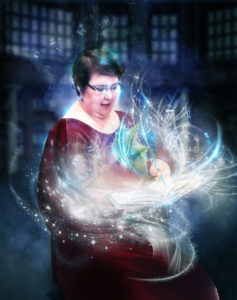 About the Author: Sheryl R. Hayes can be found untangling plot threads or the yarn her cats have been playing with. In addition to writing, she is a cosplayer focusing on knit and crochet costumes and works full time at a Bay Area water company. You can follow her at her blog, on Twitter, or on Facebook.
About the Author: Sheryl R. Hayes can be found untangling plot threads or the yarn her cats have been playing with. In addition to writing, she is a cosplayer focusing on knit and crochet costumes and works full time at a Bay Area water company. You can follow her at her blog, on Twitter, or on Facebook.
Here’s a sneak peek at Chaos Wolf:
Bitten by a werewolf. Taught by a vampire. At this rate, she’s going to start a war.
Literature major Jordan Abbey ordered a double mocha latte, but it wasn’t supposed to come with a side order bite by a love-sick werewolf. When a vampire comes to her rescue, gut instinct tells her he has questionable motives. But he’s the only one she can trust to help get in touch with her inner animal.
Within a week, her smart mouth lands her in trouble with the hostile alpha of the local pack and the stiff-necked vampire elder. She now has less than a moon cycle to master shape changing… or else. And the besotted werewolf who started this whole mess is stalking Jordan and killing her friends. He won’t take no for an answer.
In the Northern California town of Rancho Robles where the children of the Wolf and the Bat share an uneasy coexistence, one woman makes an epic mess of the status quo.
Chaos Wolf Excerpt
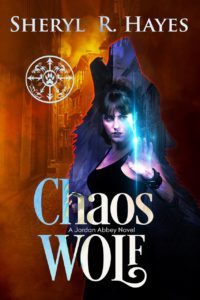 He gestured toward the couch. “Would you like tea, coffee, or soda?”
He gestured toward the couch. “Would you like tea, coffee, or soda?”
“Soda, please.” Although she wasn’t thirsty, accepting what he offered seemed the polite thing to do. She sat down on the leather couch and rested her elbows on her knees. “Don’t you only drink… um—”
“Blood?” Montgomery finished the question for her. “No.” He stepped into the kitchenette. “I can and do drink and eat other things. It’s kind of like eating junk food. There’s no nutritional value. I enjoy the flavors and textures. I don’t like to do it too often, though.”
Jordan tilted her head to one side. “Why not?”
His lip curled into a half smile. “I can’t digest matter like when I was mortal,” he explained. “I have to purge it in a different way.”
She blinked, puzzling it out. Understanding dawned on her face. “Oh… Oh!”
One red-and-silver can in hand, Montgomery stepped out of the kitchenette. “When I last saw you, you were hightailing it out of here, never to return.” He gave her the soda and took a seat in the chair sitting at a right angle to the couch. “What happened?”
Jordan stared down at the soda and rubbed her thumb over the frosty top. “After I left, I went home. I didn’t tell anyone about you.” She gestured in Montgomery’s direction. “I went out to try to forget what happened. When I came back, I found out my roommate’s boyfriend had been mauled to death.”
Montgomery stiffened. “Did you see the werewolf?”
“No,” Jordan said. “I didn’t even think he was real until…” She paused and shivered, sloshing the soda in the can. “All I could think about was finding you.”
Montgomery’s lips moved to form a curse. “Did you come directly here?” He stood up and crossed the small space separating the chair and the couch. “Focus. It’s important. Do you think you were followed?”
“No. The police took me and Molly to the station. We’re not allowed to go back to our apartment until sometime tomorrow after the super gets someone in to…” Jordan’s voice broke. She swallowed. “Clean up. I spent two hours getting on and off buses to make sure I wasn’t followed.”
Montgomery sat down on the couch. “Good thinking. If the werewolf was following you by scent, that should have thrown him off your trail. If he was tracking you by sight, you would have spotted him. Or he would have broken in here by now. You’ve been lucky.”
“Lucky?” Jordan’s shoulders tightened and her fist clenched, denting the can inward. “I’m being stalked by something out of a horror film and you think I’m lucky?”
“Yes,” Montgomery countered. “If you had been there instead of your friend, the werewolf would have finished what he started.”
“Finished what he started?” Jordan put the soda on the table unopened. “You make it sound like he let me live.”
“He did,” Montgomery stated, as if it were the most obvious thing in the world.
She stared at him with an open mouth. All the movies and books she had seen taught that a werewolf would rip out her throat as soon as look at her. The female victim never survived the attack. “But why?”
“You haven’t figured it out yet?” Montgomery appeared nonplussed by her reaction. “He wasn’t trying to make a meal out of you, Jordan. He was claiming you as his mate.”
May 10, 2018
Advice for Attending a Writing Workshop
 A student wrote in to let me know they’d made it into Odyssey, huzzah, and asked if I had any advice about attending a workshop. As a matter of fact I do. Like many things in life, you get more out of a workshop if you’re willing to invest a little effort beforehand, during, and afterward.
A student wrote in to let me know they’d made it into Odyssey, huzzah, and asked if I had any advice about attending a workshop. As a matter of fact I do. Like many things in life, you get more out of a workshop if you’re willing to invest a little effort beforehand, during, and afterward.
I went through a number of workshops in college at both the undergraduate and graduate level, but the place where I learned the most was Clarion West, a six week workshop in Seattle. My instructors were Octavia Butler, Andy Duncan, L. Timmel Duchamp, Connie Willis, Gordon van Gelder, and Michael Swanwick; my classmates included Ann Leckie, E.C.Myers, Rashida Smith, and Rachel Swirsky, among others. If you read a lot of F&SF, you may recognize many of those names and realize how incredibly privileged I was to be part of that year.
How I Prepared
Read work by your instructors. At least a few stories or a novel. Get a sense for what they will be able to give; there will be things you won’t expect, but you will learn what you like and dislike about their writing and what you want them to teach you.
Come with story ideas. Not stories, but prompts and scenes. A list of potential titles. A page where you took fifteen minutes to generate ideas.
Put other shit on hold. Clear the decks so unrelated work and deadlines is not distracting you. You want to give it your all. The spouse of one of my fellows had their children writing letters saying how much they missed the parent and wanted them to come home, and it was one of the clearest examples of someone sabotaging their partner that I have ever witnessed. Don’t let anyone do this to you. Make the most of the workshop while you can.

Useful Things I Did
Go first. One of the things that has stood me well in life is a habit of volunteering to go first, mainly due to a let’s-just-get-this-over-with-already impatience. I’ve done it every time I’ve been in a workshop and it helps you not feel that you have to live up to earlier examples. Do a nice job and you can actually be that intimidating classmate whose work people worry about living up to.
Talk to people. Your fellow students are a peer group you’ll be interacting with for years to come. Be a good citizen and avoid being a jackass, even if it’s your natural tendency. Ask people questions more than you tell them about yourself. Listen.
Take good notes. I like to write stuff down, at the time in Moleskinnes. If there was ever a time for learning to write good notes, this is it. If you have difficulty, you might ask your classmates about recording.
Take care of your body. Six weeks is a long time and one in which health issues can develop if you’re not careful. Stretch. Walk daily; work out a few times each week if you can. You will emerge more energetic and creative as a result of investing that time and effort.
What I Would Have Done Differently
You can’t go home again. I did go home two weekends in order to hang with my spouse and cats. In retrospect, while that did recharge me, I should have spent that time hanging out with my classmates since that time was pretty finite.
Take some board games. I don’t know why I didn’t think to do this, perhaps because we weren’t gaming as much then as we used to. I would take games that were easy to teach, had a timespan of never more than an hour or hour, and which stressed creativity. Examples: Codenames, Dixit, Fiasco, Microscope.
Life Post-Workshop
Grieve that idyllic life a bit. It’s okay to mourn. You will miss some of your classmates fiercely. Some will become lifelong friends; others will fade back into the world and never be heard from again.
Go back over your notes. I still go back over my notes periodically, sometimes making notes in a different color; I’m about due to review these again.
Write and write and write some more. Apply what you’ve learned. Experiment. Reply to other people’s stories with your own. And send stuff out. And welcome to you. Once you have made the first sale of six cents or more a word, join SFWA, but even before then use its resources like the SFWA Blog, Writer Beware, and the SFWA reading series across the country.
Can’t make it to a live workshop? There’s also plenty of online ones. My own Rambo Academy for Wayward Writers features two this weekend: How to Write Better Food with Cassandra Khaw and Ideas Are Everywhere with Rachel Swirsky.
Here’s a full list of live classes and details about how to take one for free. Or consult the excellent list of speculative fiction workshops Kelly Robson has compiled.
May 7, 2018
Guest Post: Kate Heartfield Excavates Food of the Underworld

Miniature depicting Hellmouth from the Hours of Catherine of Cleves
Imagine a Hellmouth. No, not the one in Sunnydale, California—a medieval Hellmouth, straight out of a manuscript illumination. Pointy teeth, flames, unhappy people.When I decided that I wanted to write a book about a medieval woman who leads a raid on Hell, that was the sort of underworld that immediately came to my mind. A mouth, though, implies a throat, and a stomach, and, well, everything else.
So I had a Hellbeast on my hands, a creature that spends centuries underground, but occasionally makes an appearance on the surface. It’s a little like a platypus, but without the bill. And a lot bigger.
Within the Hellbeast, there are revenants. But there are also humans—some have been altered in various ways, and some are extremely long-lived, but they are humans nonetheless. This led me to an unusual world-building question: What do people eat in the underworld?
That is a trick question, of course. Should you find yourself in any sort of underworld, and/or in Faerie, it’s best not to eat anything at all. The old stories are quite clear on that point. Probably the most famous example is that of Persephone, who is obliged to spend part of every year in the underworld because she ate a pomegranate seed there.
Food is a medium of communication between the world below and the world above. To be in a world—to see it, to speak to its inhabitants—is to be of that world. The food of the underworld is part of the underworld, and makes the eater part of the underworld too.
Conversely, food allows the dead to become, temporarily at least, part of the world above once more. When Odysseus wants to speak to the dead, he pours a libation of milk, honey, wine and water, and sprinkles barley meal over the whole mess, praying to Persephone, among others. What really draws the dead to him, though, is sheep’s blood that he lets run into a pit. The seer Teresias will only speak to him after drinking the blood.
Red wine and honey were also in the jars sent along to the afterlife with King Tutankhamun in Egypt, who could also choose from a variety of mummified meats slathered in tree resin.
In an underworld, food isn’t just about communication, status and sustenance. It’s often about torment. Hel, the ruler of the Norse underworld, has a plate called Hunger and a knife called Famine. Tantalus stole nectar and ambrosia, and murdered his own son to feed him to the gods. His punishment is to stand in water, with a fruit-laden branch over his head, just barely unable to drink or eat.
In Dante’s Inferno, a nobleman named Ugolino (who may have eaten his children’s bodies in the final throes of his own starvation) is frozen in a pit next to the man who betrayed him, forever gnawing on his enemy’s head. He is both tormentor and the tormented.
Hell was one of several medieval examples of a “topsy-turvy world”, writes Herman Pleij in Dreaming of Cockaigne: Medieval Fantasies of the Perfect Life. If you ate too much, or committed some other food-related sin such as cannibalism, your punishment in the world below would be to become food yourself, to be denied food, or to be forced to eat unclean or disgusting food. Gluttons would be punished by being made “to suffer such terrible hunger and thirst that they eventually beg for hay, dregs of wine, and finally excrement and urine” before being served the meat of toads or even dragons.
Sometimes, the residents of Hell punish themselves. In the allegory of the long spoons, the residents of Hell are unable to get the food to their mouths because their spoons are too long; in heaven, the same spoons cause no difficulty, as people there are kind enough to feed each other.
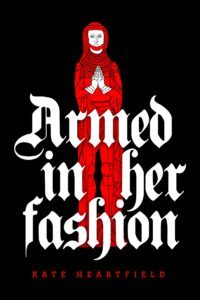 I had some ideas, then, for what sort of food would be right in my medieval European Hellbeast. Something that would be of the underworld, not just in it. Something red, to recall pomegranates and wine. Something that would be a little horrifying to the world above. Something that recalls the sacrifice Odysseus made, when he needed to bridge the world of the living and the dead. And for practical reasons, something that would be available in those long centuries when the Beast is dormant under the earth.
I had some ideas, then, for what sort of food would be right in my medieval European Hellbeast. Something that would be of the underworld, not just in it. Something red, to recall pomegranates and wine. Something that would be a little horrifying to the world above. Something that recalls the sacrifice Odysseus made, when he needed to bridge the world of the living and the dead. And for practical reasons, something that would be available in those long centuries when the Beast is dormant under the earth.
I’m sorry to say that what I came up with is the blood of the Beast itself. The denizens of Hell drink it, and they eat it, in the form of glittering balls that look a little like caviar, or like pomegranate seeds.
This is not a meal I can endorse, as a vegetarian. As a substitute, might I suggest some pomegranate tapioca?
BIO: Kate Heartfield’s debut novel Armed in Her Fashion (CZP) is available as an ebook as of April 24, and as a paperback as of May 17. Her interactive novel The Road to Canterbury is now available from Choice of Games. Tor.com Publications will publish two time-travel novellas by Kate, beginning with Alice Payne Arrives in late 2018. Her fiction has appeared in magazines and anthologies including Strange Horizons, Lackington’s, and Monstrous Little Voices: New Tales from Shakespeare’s Fantasy World. Kate is a former newspaper editor and lives in Ottawa, Canada.
 Website: https://heartfieldfiction.com/
Website: https://heartfieldfiction.com/
About Armed in Her Fashion: https://chizinepub.com/armed-in-her-fashion/
Goodreads: https://www.goodreads.com/book/show/35497377-armed-in-her-fashion
Twitter: https://twitter.com/kateheartfield
April 23, 2018
Recent Newsletter Stuff
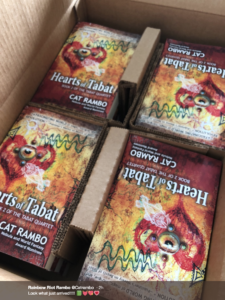 Hello!
Hello!
It’s full-on spring here in Seattle. Trees are in bloom, and construction projects have shifted into high gear, so the sidewalks are full of pylons and freshly poured concrete.
I’m looking forward to comparing this weather to other places in a few days. First South Bend, Indiana, where I’ll be speaking at the University of Notre Dame, and then Tempe, Arizona, for a two-day workshop working with scientists to write a story about solar power.
Then home for a while, where I’ll have a chance to talk with people at Crypticon here in Seattle at the end of the month (https://www.crypticonseattle.com/attend/crypticon-2018-tickets/) . Come to the Saturday writing workshop with me! I’ve secured the awesome Kay Kenyon as a co-teacher.
This newsletter marks some changes in the structure of my Patreon campaign (https://www.patreon.com/catrambo) , and its linkage into the Rambo Academy for Wayward Writers. Even if you’re not a Patreon supporter, you’ll want to bookmark the page, because I’ll be providing some free stuff there each month, courtesy of the supporters.
Everyone, signed up or not, gets the following on the Patreon page:
* 1-2 writing snippets each week from Cat’s current work and the chance to ask questions and offer feedback about them
* Access to the first Ask-Me-Anything Friday session of each month. Check out the post and ask whatever you like. Past questions have included career advice, recommended reading, insider SFWA news, writing feedback, and more.
* Occasional random stuff
All Patreon supporters get the above plus:
* 1-2 monthly stories or chapters and the chance to ask questions and offer feedback about them.
* Access to weekly Tasty Thursday recipes andAsk-Me-Anything Friday sessions
* Special patron-only events & giveaways at conventions
* The former student rate on live classes thru the Rambo Academy ($79 instead of $99)
* More random things at whim
$2 supporters get the above plus:
* 1-3 market news or advice posts per week
* 1-3 writing tip or resource posts per week
* One photo of Taco each month
* Random (usually writing-focused) things
$5 supporters get the above plus:
* All ebooks as they are released
* Access to the Chez Rambo Discord server and the #general, #bookclub, #critclub, #motivation, #news, and an exclusive #patreon channels.
* The usual randomness, usually in the form of chatter in Discord
$10 supporters get the above plus:
* 1 live or on-demand class per year (non-cumulative, starts on 3^rd month)
* Oh surprise, random things
$25 supporters get the above plus:
* Monthly story prompts post
* 1 live or on-demand class every 3 months (non-cumulative, starts on 3^rd month)
* *Rolls a dice* Something random
$50 supporters get the above plus:
* 1 live or on-demand class each month (non-cumulative)
* Even more
$100 supporters get the above plus:
* Monthly 15-30 minute coaching session, live class, or on-demand class
If you’re curious what Patreon is and how it works, there’sa two minute video of me explaining it here (https://www.patreon.com/catrambo) . We’ve been really enjoying the Discord community so far, and using it for writing sprints as well as chatter and questions.
Look what arrived literally moments ago! Yay! So excited to see all my hard work in tangible form. The electronic version is available for pre-order here (https://amzn.to/2qQuhEW) ; the hardcopy preorder should be available again sometime this week.
** Class News
————————————————————
The next class coming up is Cassandra Khaw’s Writing Better Food (http://www.kittywumpus.net/blog/how-to-write-better-food-with-cassandra-khaw/) on Saturday, May 12, followed by Ideas are Everywhere with Rachel Swirsky (http://www.kittywumpus.net/blog/ideas-are-everywhere-with-rachel-swirsky/) the following day on Sunday, May 13.
Scott H. Andrews has kindly agreed to give his Short Story Openings workshop (http://www.kittywumpus.net/blog/short-story-openings/) again for people who missed the first version, this time on June 16. A recent addition is a workshop with Doug Smith on July 14 on story rights and reprints. Keep an eye out for it or drop me a drop to go ahead and preregister; usual price.
Find out about all current classes here (http://www.kittywumpus.net/blog/academy/) .
If you enjoy gaming, check out Cat in Esper Genesis (https://www.twitch.tv/videos/252653827) – D&D5E in space — in which Cat runs Petra Cinis, a woman with a Very Large Hammer.
April 16, 2018
Press Release: Hearts of Tabat
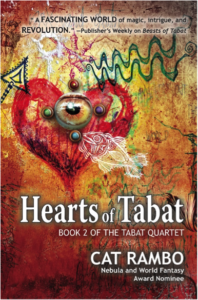 Look at the pretty press release Wordfire put together!
Look at the pretty press release Wordfire put together!
FOR IMMEDIATE RELEASE
Dryads. Minotaurs. Centaurs. Can magical creatures force social revolution in Tabat?
Monument, Colorado. WordFire Press is proud to announce the release of HEARTS OF TABAT, Book 2 of the Tabat Quartet by Nebula and World Fantasy Award Nominee, Cat Rambo.
“a fascinating world of magic, intrigue, and revolution.” —Publisher’s Weekly on Beasts of Tabat
In Tabat, Beasts — magical creatures like dryads, minotaurs, and centaurs — question a social order forcing them into its lowest level. Adelina Nettlepurse, scholar and secret owner of Spinner Press, watches history being made around her as the city prepares for change, only to find herself faced with the greatest challenge of her life.
In the second book of the Tabat Quartet, award-winning author Cat Rambo expands the breathtaking story from Beasts of Tabat with new points of view as Adelina, Sebastiano, and others add their voices. Tabat is a world, a society, and a cast of characters unlike any you have read before.
Adelina Nettlepurse, noted historian and secret owner of Spinner Press, watches the politics and intrigue with interest, only to find herself drawn into its heart by a dangerous text and a wholly unsuitable love affair with a man well below her station. When Adelina’s best friend, glamorous and charming gladiator Bella Kanto, is convicted of sorcery and exiled, the city of Tabat undergoes increasing turmoil as even the weather changes to reflect the confusion and loss of one of its most beloved heroes.
For interviews, more information, or to request a review copy, please contact us at info@wordfire.com.
Hearts of Tabat
Trade paperback $19.99. ISBN 978-1-61475-637-8
Ebook $5.99. ISBN 978-1-61475-638-9
Coming May, 2018
WordFire Press is a mid-size new-model publisher founded by New York Times bestselling authors Kevin J. Anderson and Rebecca Moesta. You can find us at wordfirepress.com. Tweet us @WordFirePress. Follow us on Facebook at facebook.com/WordfireIncWordfirePress.
March 27, 2018
Guest Post: R J Theodore Gives Away an Old Family Secret
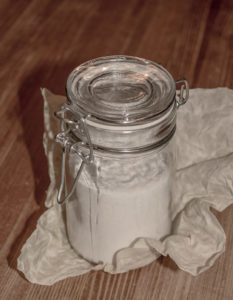 Everybody’s tried to make a meal they mess up. A pile of perfectly good ingredients that just won’t come together into something palatable despite our best efforts. And when time and money and supplies are tight, sometimes tossing out the pot and starting over is not an option.
Everybody’s tried to make a meal they mess up. A pile of perfectly good ingredients that just won’t come together into something palatable despite our best efforts. And when time and money and supplies are tight, sometimes tossing out the pot and starting over is not an option.
In each act of my new spacepunk steam opera novel, FLOTSAM, the four-person airship crew sits down to a meal. They come together to eat, to debate, and to problem solve. Their thoughts in these scenes are filled with worry over finding work, getting paid, keeping the ship in good repair, and staying out of trouble long enough to spend any money left after that.
Each meal is a backdrop to what’s going on in the story at that moment: an easy, familiar meal to celebrate getting away from a confrontation in one piece; a load of their favorite takeout as distraction from unpleasant news; and, finally, a dinner that goes horribly wrong before coming together in the end.
FLOTSAM’s Captain Talis is as reckless in the galley as she is in life. When the crew members normally in charge of cooking are otherwise engaged in higher priority duties, Talis volunteers herself to fix them something to eat. She fumbles her way through dinner preparation until the engineer discovers her at work on an over-salted, unpalatable meal and firmly ejects her from the galley. When the captain later tastes the food she’s amazed that it has transformed into a rich, balanced, and flavorful chowder.
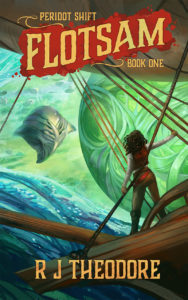 Even in secondary world fiction there is research to be done. During one revision pass of FLOTSAM, I double-checked a piece of cooking advice I picked up somewhere: that you can add a starchy vegetable to the pot to draw in excess salt. This proved to not be the case, as an oversalted meal needs not one starchy vegetable or even a pile of starchy vegetables, but rather an increase in every other flavor and ingredient in the meal to balance itself out. There are no magic bullets or miracle treatments.
Even in secondary world fiction there is research to be done. During one revision pass of FLOTSAM, I double-checked a piece of cooking advice I picked up somewhere: that you can add a starchy vegetable to the pot to draw in excess salt. This proved to not be the case, as an oversalted meal needs not one starchy vegetable or even a pile of starchy vegetables, but rather an increase in every other flavor and ingredient in the meal to balance itself out. There are no magic bullets or miracle treatments.
The disastrous meal was a critical component of the final act. The situation that limited their menu options, the botched attempt to make something of it, and the meal’s subsequent salvation were deliberately crafted and I was reluctant to fudge the details.
I turned to my friend, a classically trained chef and cookbook writer, in the hopes they could give my scene a pass of plausibility as I described it. When I was told that there’s no easy fix, I felt lost. Frustrated. This big important scene became implausible and people would stop reading, throwing the book across the room because I stretched credulity well past its breaking point.
My friend reminded me, “It’s Science Fiction and a different planet; who’s to say they don’t have a fix?”
It is a different planet. It is a different reality. I’ve knocked it down and built it up so many times over and over in different ways, there wasn’t any reason why the rules of cooking couldn’t also be knocked down and rebuilt.
I rolled up my sleeves, thought about the oversalted dinner and the rules of the world and the characters who abided by them, and finished the scene with only minimal adjustments.
In FLOTSAM’s final draft, the ship’s engineer brandishes a jar of something she calls “an old family secret” and chases the captain from the galley. The draft saved the amusing interactions between characters along with the parallel between the meal and the situation aboard the airship. And along with the dinner’s saltiness went my own self-conscious over-explanation. My characters gathered in the next scene over a hearty meal and hoped, despite everything they’d been through, things just might turn out okay.
And now that dish might be my favorite meal in the novel.
About the Author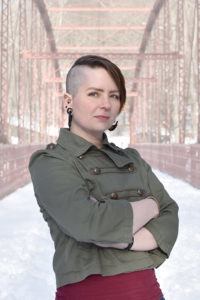 R J THEODORE (website) is hellbent on keeping herself busy. Seriously folks, if she has two spare minutes to rub together at the end of the day, she invents a new project with which to occupy them.
R J THEODORE (website) is hellbent on keeping herself busy. Seriously folks, if she has two spare minutes to rub together at the end of the day, she invents a new project with which to occupy them.
She lives in New England with her family, enjoys design, illustration, podcasting, binging on many forms of visual and written media, napping with her cats, and cooking. She is passionate about art and coffee. Follow her on Twitter @bittybittyzap.
Book One of the Peridot Shift series (Parvus Press), FLOTSAM is Theodore’s debut science fiction novel, available March 27, 2018 in print, digital, and audio.

